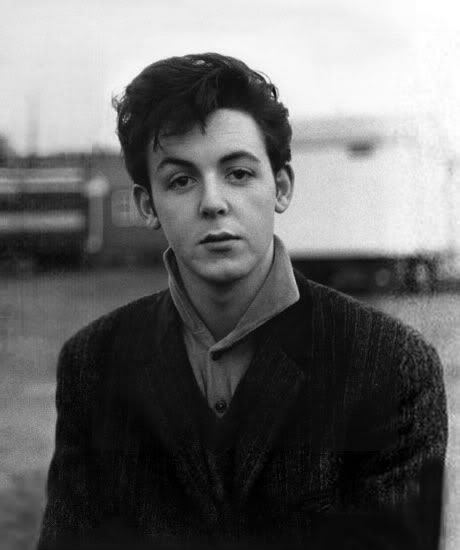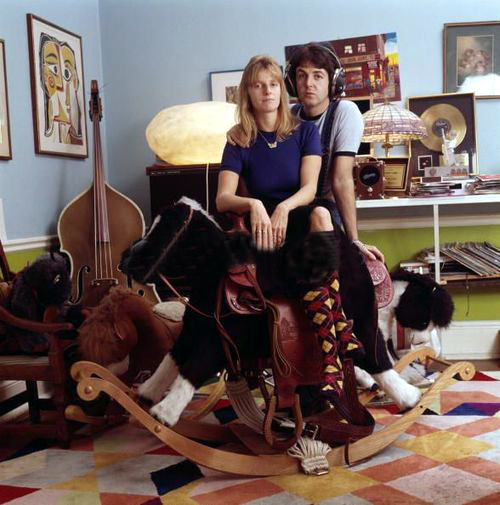Sir Paul McCartney was born James Paul McCartney in Liverpool in 1942. His father, Jim McCartney worked as a cotton salesman and his mother, Mary, worked as a nurse and midwife. Paul’s dad had a talent for music too, and was a keen pianist: he even had his own band, called Jim Mac’s Jazz Band. Paul’s younger brother, Michael, is better known as Mike McGear, the Liverpool poet who belongs to a group called The Scaffold. Mike uses the stage name McGear so as not to capitalise on his older brother’s fame.
Growing up in Liverpool just after World War II, Paul enjoyed a happy and uneventful childhood and showed an early gift for music and also for art. He did well at primary school and was one of only four pupils in his year to pass the 11+ exam. His success earned him a place at the prestigious Liverpool Institute for Boys, which he attended from 1953 until 1960. Paul left school having passed “A” levels in English and Art.
Paul’s happy childhood came to an abrupt end when he was 14-years-old, and his beloved mother died very suddenly and unexpectedly from breast cancer. Paul was devastated by this tragic loss and turned to music and writing songs in order to try and come to terms with his mother’s death.
A short while later, he was performing music at a local church fete, when he happened to meet a fellow budding musician called John Lennon. At that time, John had already formed his own band, called The Quarrymen, and he was so impressed by Paul’s guitar skills and versatile singing ability that he invited him to come and join his band. Over the course of the next few years, John Lennon added George Harrison and Pete Best to the line-up, and the band changed its name to The Beatles. The rest, as they say, is history.
In the beginning, the band played most of their gigs in their home town Liverpool, at a venue called The Cavern Club, and made a brief foray over to Germany, where they played in Hamburg. By the end of 1961, the boys had decided that they needed to find a manager, and chose local businessman Brian Epstein for the job. Epstein was a skilful entrepreneur and helped the boys to improve their image and make the most of their raw, unpolished talents. Epstein also replaced drummer Pete Best with Ringo Starr, and helped the boys secure a recording contract with EMI. Paul became the lead vocalist with The Beatles, as well as playing a variety of instruments, including bass guitar, acoustic and electric guitar, piano and keyboards. He reportedly also played upwards of three dozen other musical instruments.
Paul was not only a multi-talented instrumentalist, he was also a gifted songwriter, and he and John Lennon wrote many of the hit songs together during the Beatles years. Back in 1957, whilst they were still both teenagers, John and Paul agreed that every song they wrote together would have 50/50 ownership, and they stuck to this agreement in later years, despite the fact that such an oral contract wasn’t legally binding, as they were still both minors.
Even though both John and Paul wrote a great many songs individually, over 200 songs that were recorded by The Beatles are still formally credited to both men. Many of the songs evolved during the band’s jamming sessions: the 1963 classic number, “I Want To Hold Your Hand” is one such song. Paul’s most famous songs have all become classics: perhaps the most famous of these are Yesterday, Eleanor Rigby, Let It Be, When I’m 64, and Blackbird. “Yesterday” is arguably perhaps the most famous song ever written, since over 3,000 cover versions of it have been recorded by hundreds of artists, since it was first published. Many of the Beatles songs and cover images were quite political, and promoted values of peace, freedom and the liberation of the imagination.
As well as revolutionising the music of the day, The Beatles’ music and style had a massive impact on popular culture. As a band, they were massively popular, particularly with teenage girls, and tended to be greeted by hysterical crowds of screaming fans whenever they arrived in a city to play a gig. This phenomenon soon became known as “Beatlemania”! Everything about them, their clothes, their hairstyles, was widely copied. It might well be said that they were the original “boy band”.
In 1967, the band suffered a terrible loss, when their manager Brian Epstein died. From that point onwards, the Beatles began to lose their unified creative focus, and all four members began to develop their individual creative ambitions. In 1969, Paul married his first wife Linda, whom he’d met in a London nightclub called The Bag O’Nails. Linda was a musician too, and quite soon after his marriage, Paul formed his own band, called Wings. Paul’s first solo album, “Maybe I’m Amazed” was a number One hit, and his new band Wings soon became one of the most successful groups in the world during the 1970s; the album “Band On The Run” won two Grammy Awards. In 1977, Wings released “Mull of Kintyre”, which was No. One in the UK charts for nine weeks, and became the highest selling single record for seven years. In 1979, Paul teamed up with fellow musician Elvis Costello to help organise benefit concerts for the people of Cambodia.
As the 1980s dawned, Paul encountered a run of bad luck. In 1980, he was arrested in Tokyo for possession of marijuana, and spent ten days in jail. This scandalous event provoked a massive media response throughout the world, and when Paul was released from prison, he retreated into seclusion for the major part of the following year. Fate also struck a tragic blow in December 1980, when his former song writing buddy and fellow Beatle John Lennon was killed by an assassin’s bullet outside his apartment building in New York. The tragedy caused Paul to retreat still further from the public eye, and he did not appear in public again until 1982, when he released his new album, “Tug Of War”.
Paul pursued a highly successful career as a solo recording artist, and also found time to explore different forms of musical composition. During the 1990s, he composed several pieces of classical music for the Royal Liverpool Philharmonic Society, including “The Liverpool Oratorio”, which was written for a choir and symphony orchestra, and a work for solo piano entitled “A Leaf”. In 1994, the three surviving members of The Beatles re-united and produced John Lennon’s unpublished song “Free As A Bird”, which had been preserved by Yoko Ono on a tape recording made in 1977.

Sadly, in 1995, Linda was diagnosed the breast cancer, the same disease that had claimed the life of Paul’s mother: Paul nursed Linda during her illness, and she fought the disease bravely, but to no avail. Linda died in April 1998, after she and Paul had been married for almost 30 years. Shattered by his loss, Paul retreated into seclusion once again. In 2000, Paul released the album “A Garland For Linda”, which was a tribute album, the proceeds of which were donated to help survivors of cancer. In 1997, Paul became Sir Paul McCartney, when he was knighted by the Queen.
Since Linda’s death, Paul has pursued both his interest in classical music, and his own solo recording career. He released a classical album, “Working Classical” at the end of 1999, and an album of rock’n’roll covers called “Run Devil Run”, also in 1999. His latest classical album, “Ecco Cor Meum” (Behold My Heart) was widely acclaimed, and was also voted Classical Album of The Year in 2007.
INFO:




Hi, Can you tell me where the image of Paul came from? The second one down, also used in your thumbnail image. I’m desperate to find the source! If you could get in touch with me offline. I’m a Photo Editor and I’d like to use it but I need to know where it came from.
Thanks! Hope to hear from you soon.
Im sorry…but I don’t know. I got these off the internet. 🙂